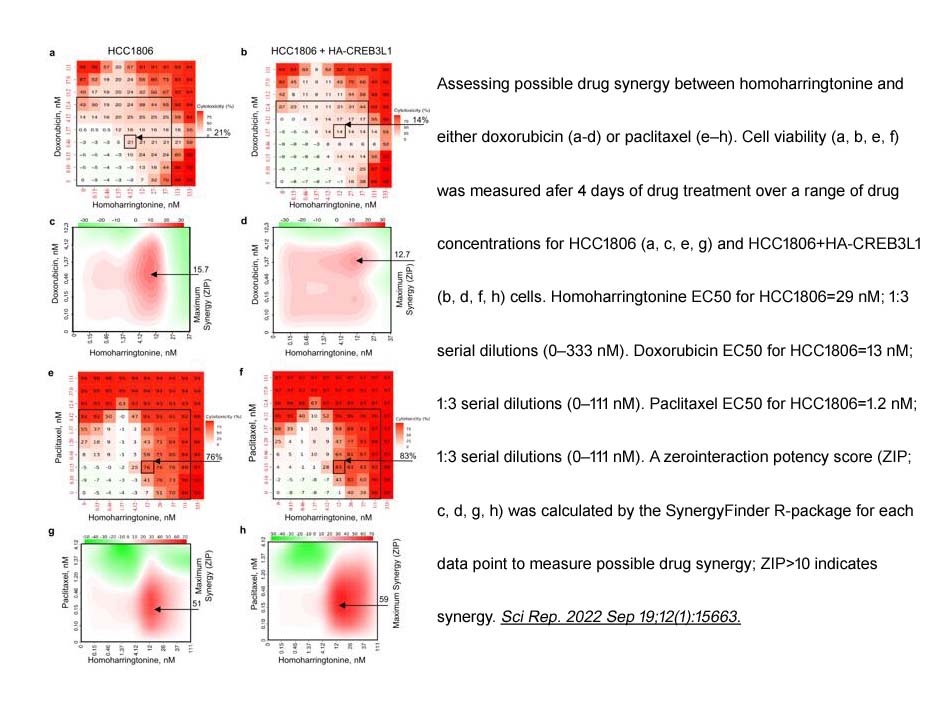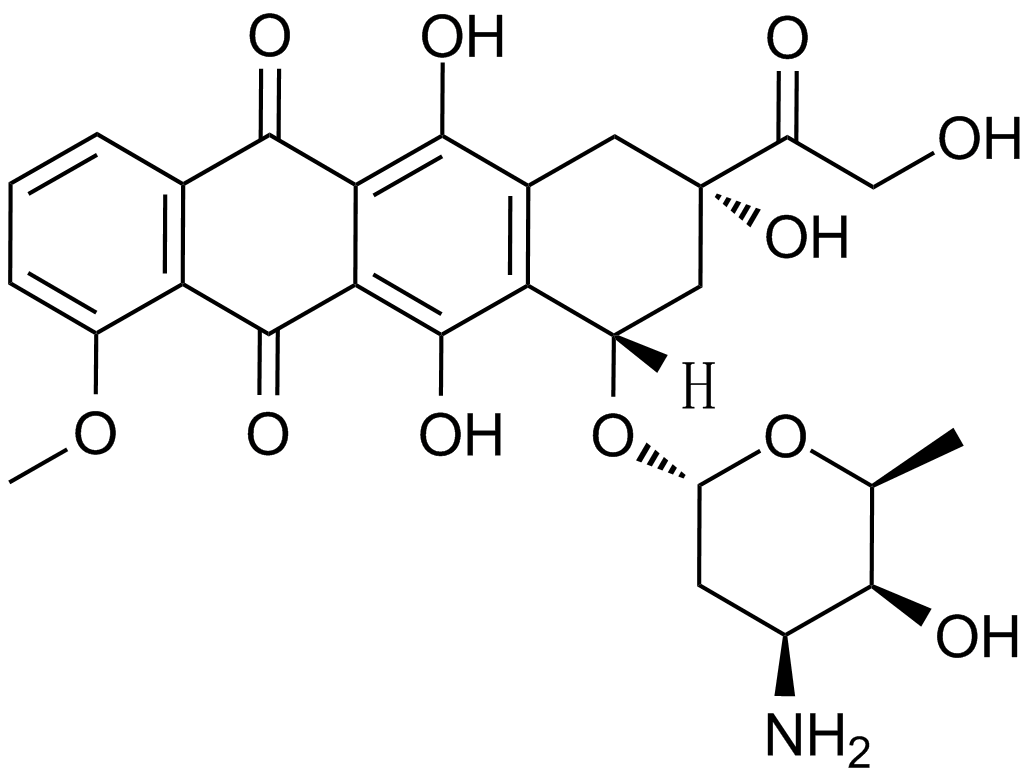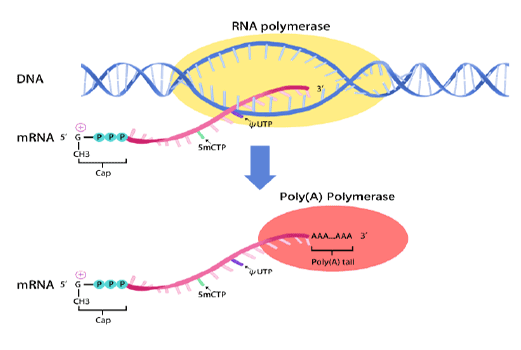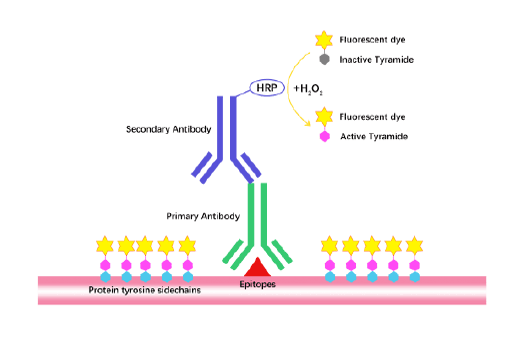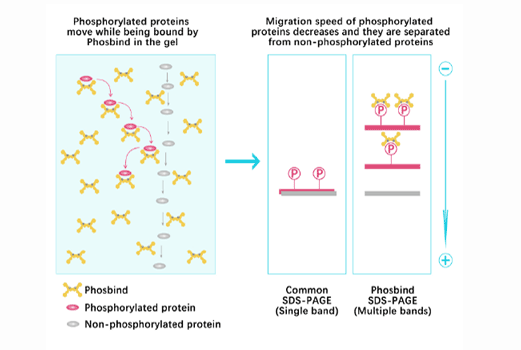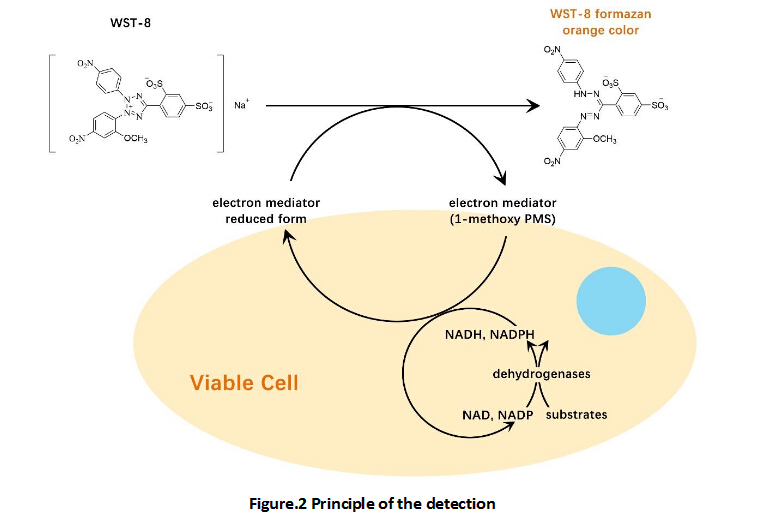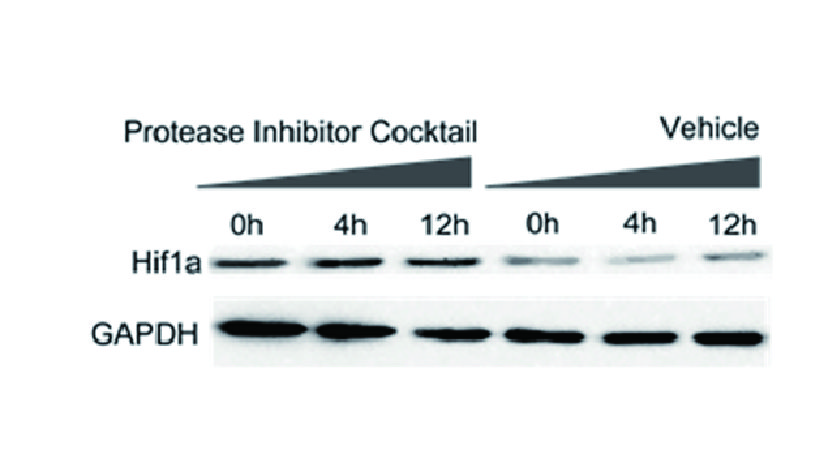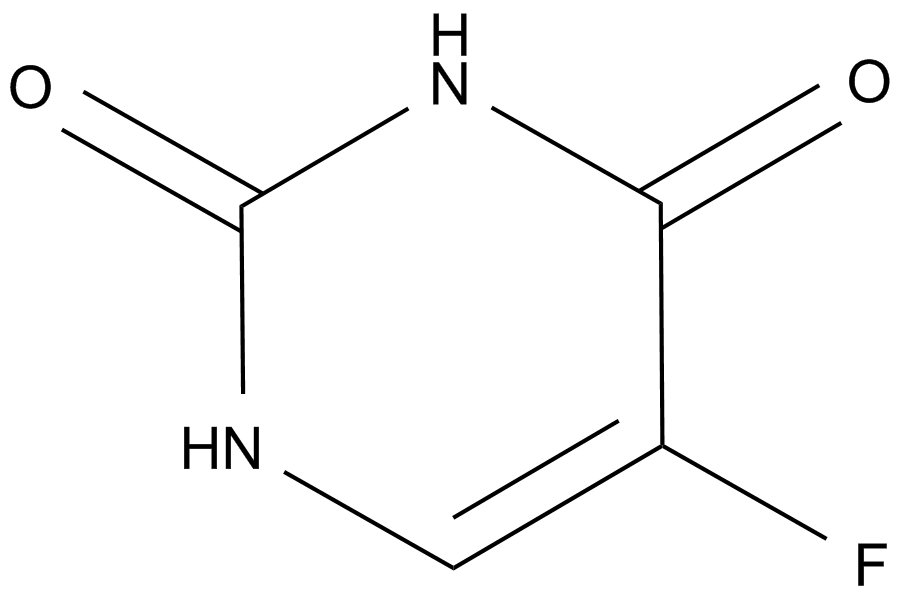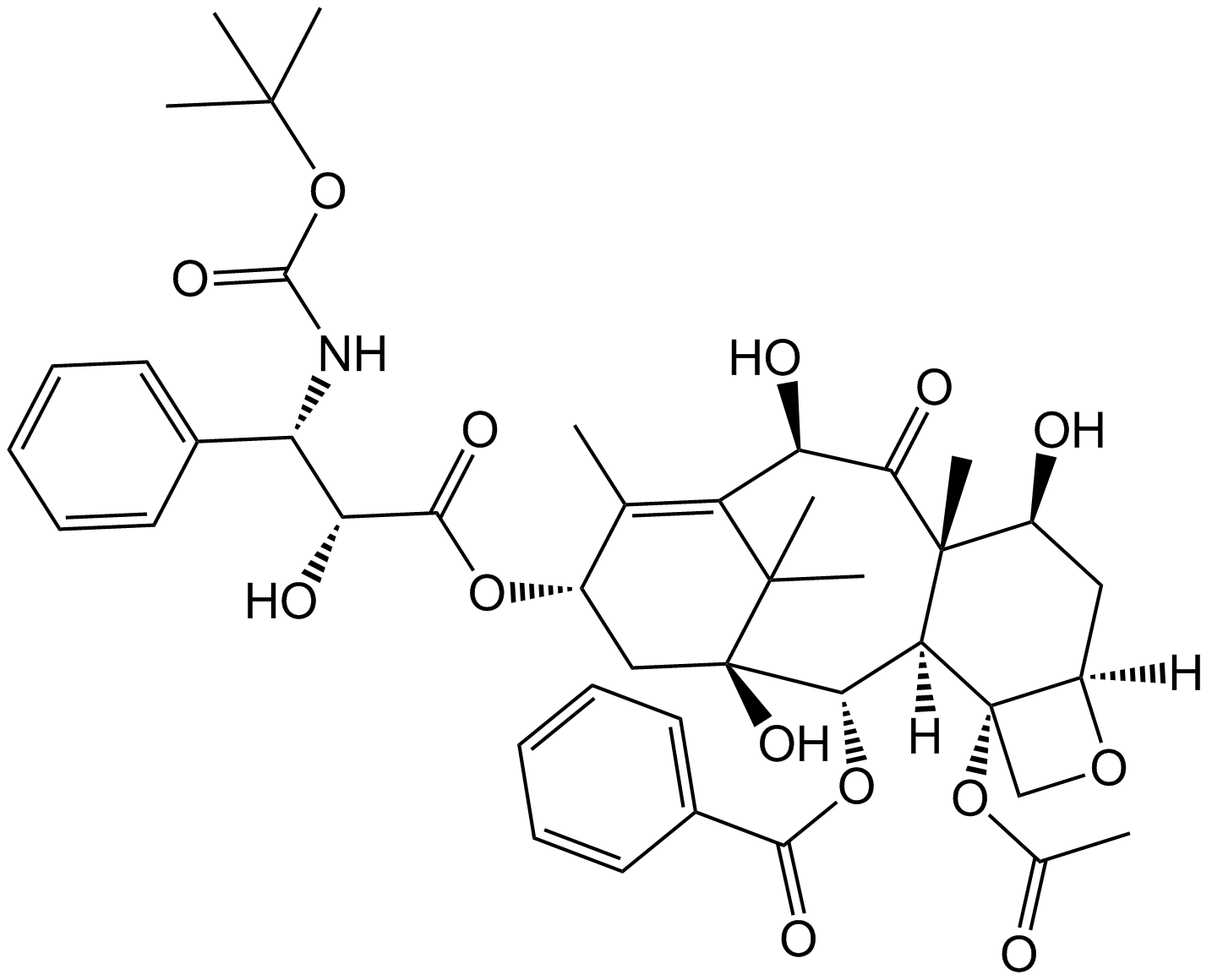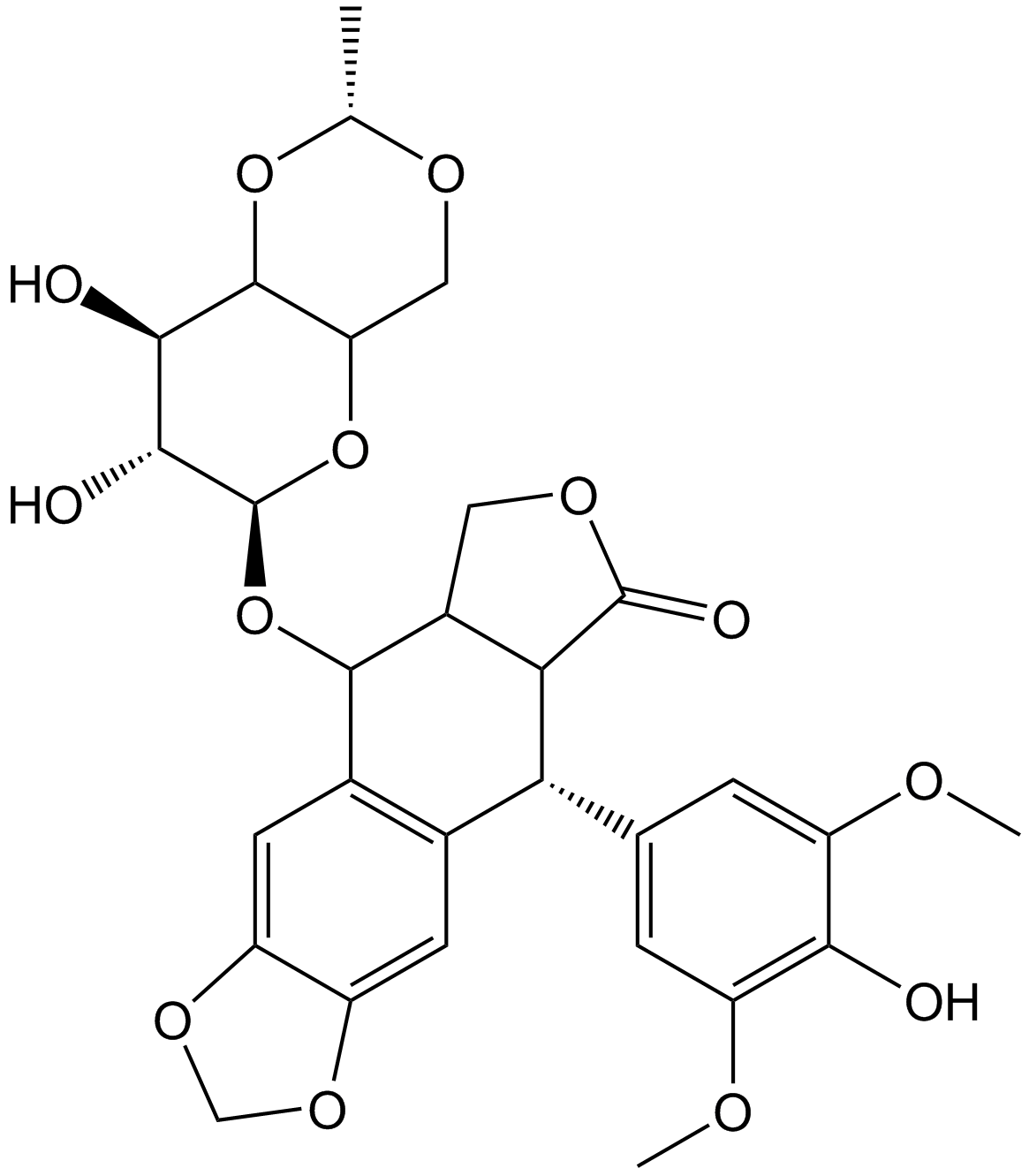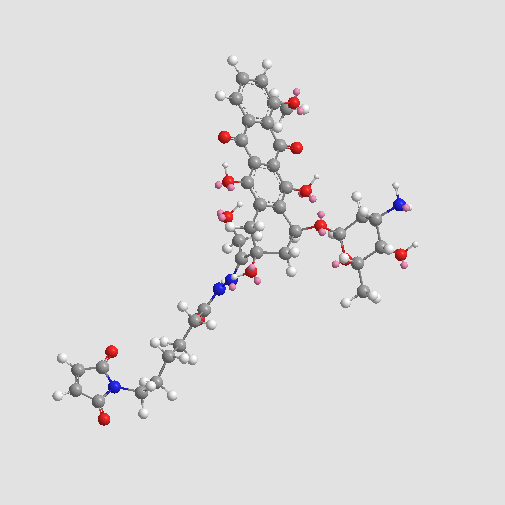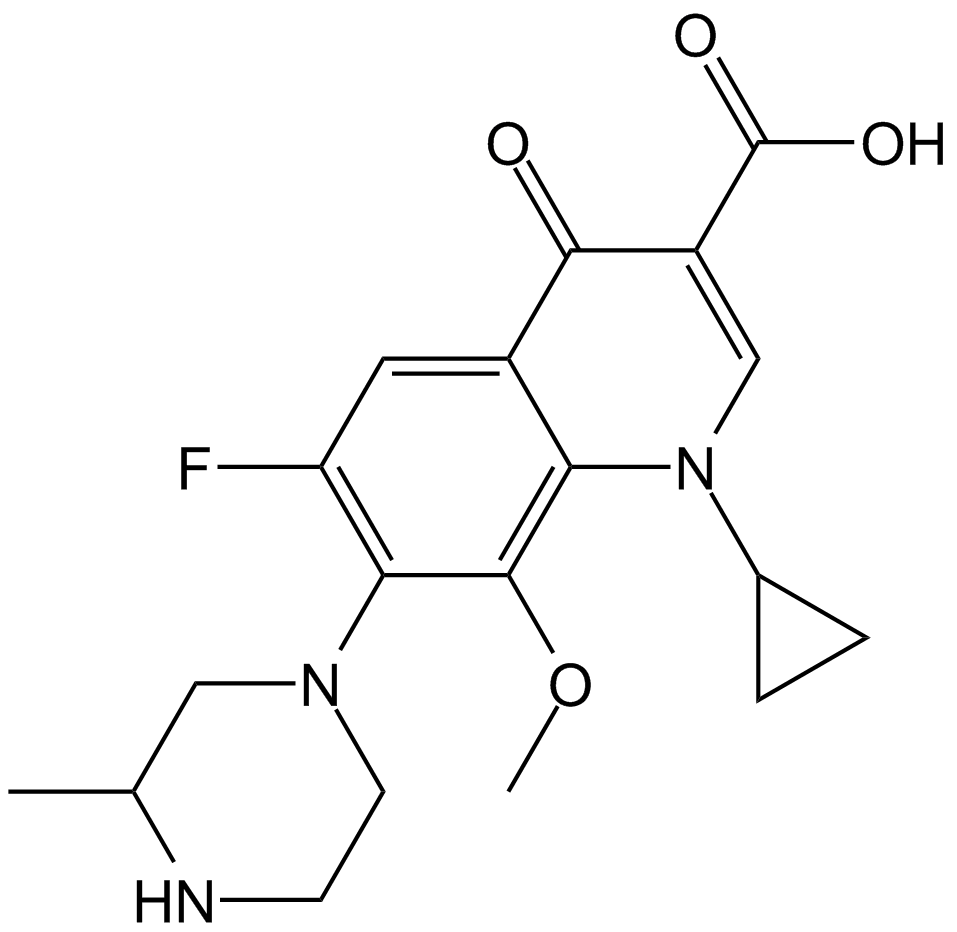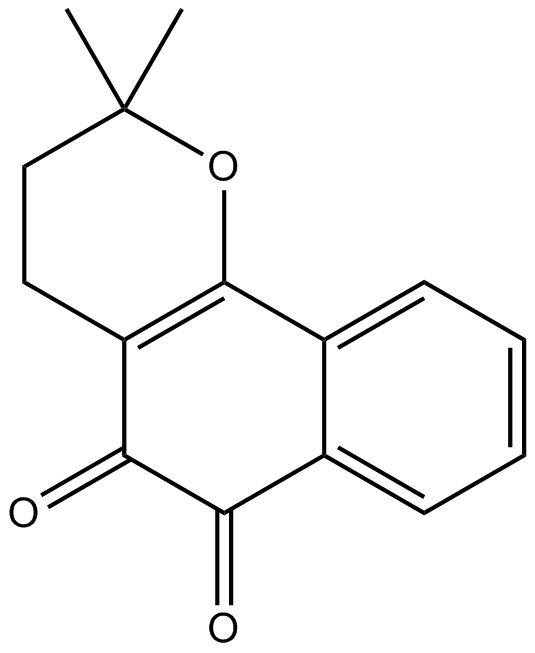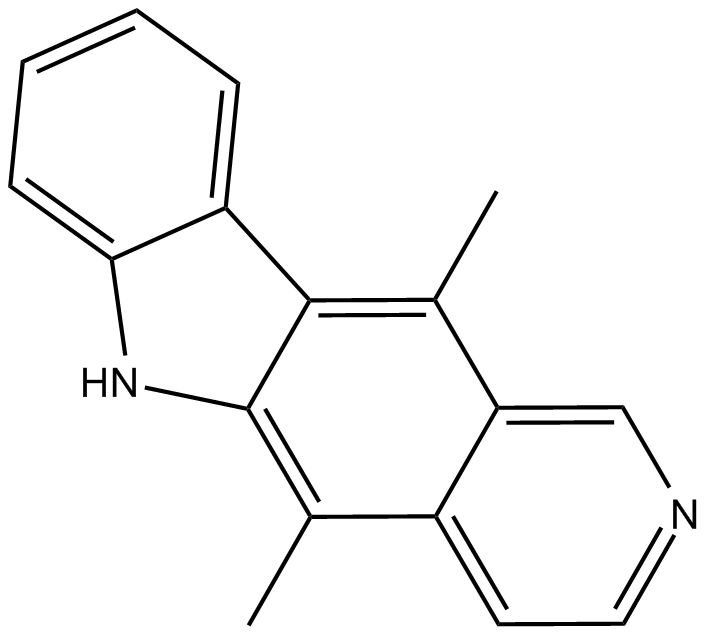Doxorubicin
Doxorubicin (CAS 23214-92-8) is an anthracycline antibiotic commonly used as an anti-cancer agent targeting DNA replication machinery. Its mechanism of action involves intercalation into DNA double helices and subsequent inhibition of DNA topoisomerase II, impeding DNA synthesis and causing genomic instability. Additionally, Doxorubicin mediates chromatin remodeling by facilitating histone displacement from active chromatin, contributing further to DNA damage and transcriptional dysregulation. It is extensively employed in studies involving hematologic malignancies, solid tumors, and sarcomas, frequently serving as a chemotherapeutic reference compound. In biochemical assays, Doxorubicin has demonstrated inhibitory effects on Topoisomerase II with an IC50 typically ranging between 1-10 µM, depending on assay conditions and cell lines applied.
References:
[1]Brayfield, A, ed. (2013). Doxorubicin. Martindale: The Complete Drug Reference. Pharmaceutical Press. Retrieved 15 April 2014.
[2]Pommier Y., et al. (2010). DNA topoisomerases and their poisoning by anticancer and antibacterial drugs. Chemistry & Biology 17 (5): 421–433.
[3]Pang, B., et al. (2013). Drug-induced histone eviction from open chromatin contributes to the chemotherapeutic effects of doxorubicin. Nature Communications 4 (5): 1908
[4]Boucek RJ., et al. (1987). The major metabolite of doxorubicin is a potent inhibitor of membrane-associated ion pumps. A correlative study of cardiac muscle with isolated membrane fractions. J of Biol Chem 262: 15851-15856.
- 1. Tatjana Maravic, Giulia Petrucci, et al. "In Vitro Study of Cold Atmospheric Plasma–Induced Proliferation Inhibition and Morphological Changes in Head and Neck Carcinoma Cell Lines." J Dent. 2025 Jul 29:161:106007 PMID: 40744292
- 2. Yue Wang, Chen Wei, et al. "A pH-sensitive peptide amphiphilic-based drug delivery system inhibits hepatocellular carcinoma growth by suppressing hepatic stellate cell activation." Mater Today Bio. 2025 Apr 30:32:101821 PMID: 40453820
- 3. Ting Gao, Yufeng Tang, et al. "Neuraminidase 1 Exacerbated Glycolytic Dysregulation and Cardiotoxicity by Destabilizing SIRT1 through Interactions with NRF2 and HIF1α." Adv Sci (Weinh). 2025 May 24;12(25):2414504 PMID: 40411250
- 4. Xuan Wang, Qiqi Sun, Jianrong Li, Baoyong Lai, Xiaohua Pei, Nana Chen et al. "Effect of Fangxia-Dihuang Decoction on doxorubicin-induced cognitive impairment in breast cancer animal model." Front Oncol. 2025 Apr 28:15:1515498 PMID: 40356765
- 5. Lishuang Cui, Qing Xia, et al. "Luteolin - 7 - O - glucuronide alleviates doxorubicin - induced cardiotoxicity by inhibiting PPAR - mediated ferroptosis." Toxicol Appl Pharmacol. 2025 Jul:500:117381 PMID: 40345555
- 6. Ning Wang, Chenxi Qiao, et al. "Acetylation of Short Glycopeptides Enables Phase Separation." Biomacromolecules. 2025 Mar 10;26(3):1595-1603 PMID: 39903822
- 7. Kun Li, Kun-Mao Jiang, et al. "Inhibition of NETs prevents doxorubicin-induced cardiotoxicity by attenuating IL-18-IFN-γ-Cx43 axis induced cardiac conduction abnormalities." Int Immunopharmacol. 2025 Feb 6:147:114016 PMID: 39805175
- 8. Aimei Li, Xue Tian, et al. "Alkaline phosphatase-responsive peptide amphiphiles promote the apoptosis of HER2-positive breast cancer cells via increased drug accumulation." Colloids and Surfaces A: Physicochemical and Engineering Aspects. Volume 718, 5 August 2025, 136848
- 9. Wenli Xie, Qing Xia, et al. "Structural characterization and cardioprotective activities of natural polysaccharides from Apocynum venetum L." Chem. Biol. Technol. Agric. 12, 81 (2025)
- 10. Asena Aynaci, Maxence Toussaint, et al. "Disruption of Man-6-P-Dependent Sorting to Lysosomes Confers IGF1R-Mediated Apoptosis Resistance." Int J Mol Sci . 2025 Apr 10;26(8):3586
- 11. N Daneshvar Baghbadorani, M Bosso, et al. "A novel in vitro 3D cancer model based on modular tissue engineering approach." bioRxiv. March 01, 2025
- 12. Eduard Reznik, Fereshteh Zandkarimi ,Joleen M. Csuka. "Lipidomic changes in persister cancer cells drive enhanced ferroptosis sensitivity." Ferroptosis Oxid Stress. 2025;1:202501
- 13. Siyuan Li, Wencheng Zhang, et al. "Serum sSelectin-L is an early specific indicator of radiation injury." Heliyon. 2024 May 8;10(10):e30527 PMID: 38778981
- 14. Ivonne González-Gamboa, Adam A Caparco, et al. "Inter-coat protein loading of active ingredients into Tobacco mild green mosaic virus through partial dissociation and reassembly of the virion." Sci Rep. 2024 Mar 26;14(1):7168 PMID: 38532056
- 15. Baiying Lei, et al. "Morphology-based deep learning enables accurate detection of senescence in mesenchymal stem cell cultures." BMC Biol. 2024 Jan 2;22(1):1 PMID: 38167069
- 16. Sookil Tae, Hye Yeon Lee, et al. "Senolytic and Senomorphic Effects of Lactobacillus plantarum DS0037 Derived Exosome-like Nanovesicles." Journal of the Society of Cosmetic Scientists of Korea Volume 50 Issue 4 / Pages.335-348 / 2024 / 1226-2587(pISSN) / 2288-9507(eISSN)
- 17. Shudan Wang, Mingcai Chen, et al. "Shexiang Baoxin Pills alleviate doxorubicin-induced cardiotoxicity via the reactive oxygen species-mediated AKT/Bcl-2 pathway." Published in Medicine 27 December 2024
- 18. Min Wang, Fang Zhou, et al. "The transcription factor PPARA mediates SIRT1 regulation of NCOR1 to protect damaged heart cells." Cardiovascular Diagnosis & Therapy Vol 14, No 5 (October 31, 2024)
- 19. Meng Wang, Dongfang Xie, et al. "Multiple ingredients of a Chinese medicine formula Sheng-Mai-San coordinately attenuate doxorubicin-induced cardiotoxicity." Pharmacological Research - Modern Chinese Medicine. Volume 8, September 2023, 100281
- 20. Riley Plett, Paul Mellor, et al. "Homoharringtonine demonstrates a cytotoxic effect against triple-negative breast cancer cell lines and acts synergistically with paclitaxel." Sci Rep. 2022 Sep 19;12(1):15663 PMID: 36123435
- 21. Boqin Hu, Dong Zhen, et al. "Ethanol extracts of Rhaponticum uniflorum (L.) DC flowers attenuate doxorubicin-induced cardiotoxicity via alleviating apoptosis and regulating mitochondrial dynamics in H9c2 cells." J Ethnopharmacol. 2022 Apr 24;288:114936 PMID: 35007682
- 22. Hai-Bing Yang, Zhao-Yang Lu, et al. "Selenium Attenuates Doxorubicin-Induced Cardiotoxicity Through Nrf2-NLRP3 Pathway." Biol Trace Elem Res. 2021 Aug 30 PMID: 34462843
- 23. Ji Yun Lee, Joo Hyun Kim, et al. "EGR1 as a potential marker of prognosis in extranodal NK/T-cell lymphoma." Sci Rep. 2021 May 14;11(1):10342 PMID: 33990633
- 24. Zhongying Gong, Xiaoying Liu, et al. "Tumor acidic microenvironment-induced drug release of RGD peptide nanoparticles for cellular uptake and cancer therapy." Colloids Surf B Biointerfaces. 2021 Mar 4;202:111673 PMID: 33714186
- 25. Wang X, Wang Q, et al. "TFEB-NF-κB inflammatory signaling axis: a novel therapeutic pathway of Dihydrotanshinone I in doxorubicin-induced cardiotoxicity." J Exp Clin Cancer Res. 2020;39(1):93 PMID: 32448281
- 26. Gong Z, Lao J, et al. "pH-Triggered geometrical shape switching of a cationic peptide nanoparticle for cellular uptake and drug delivery." Colloids Surf B Biointerfaces. 2020;188:110811 PMID: 31982793
- 27. Qi W, Boliang W, et al. "Cardamonin protects against doxorubicin-induced cardiotoxicity in mice by restraining oxidative stress and inflammation associated with Nrf2 signaling." Biomed Pharmacother. 2020;122:109547 PMID: 31918264
- 28. Gong Z, Shi Y, et al. "Plasma Amine Oxidase-Induced Nanoparticle-to-Nanofiber Geometric Transformation of an Amphiphilic Peptide for Drug Encapsulation and Enhanced Bactericidal Activity." ACS Appl Mater Interfaces. 2020;12(4):4323–4332 PMID: 31899611
- 29. Gong Z, Liu X, Wu J, et al. "pH-triggered morphological change in a self-assembling amphiphilic peptide used as an antitumor drug carrier." Nanotechnology. 2020;31(16):165601 PMID: 31891937
- 30. Ji Yun Lee, Joo Hyun Kim, et al. "Gene Expression Profiling in Extranodal NK/T-Cell Lymphoma." Research Square. December 4th, 2020
- 31. Yan L, Ding B, et al. "Inhibition of SMYD2 suppresses tumor progression by down-regulating microRNA-125b and attenuates multi-drug resistance in renal cell carcinoma." Theranostics. 2019 Oct 22;9 (26):8377-8391 PMID: 31754403
- 32. Wang Z, Chen J, et al. "cGAS/STING axis mediates a topoisomerase II inhibitor-induced tumor immunogenicity." J Clin Invest. 2019 Aug 13;130:4850-4862 PMID: 31408442
- 33. Wang X, Li C, et al. "Tanshinone IIA Restores Dynamic Balance of Autophagosome/Autolysosome in Doxorubicin-Induced Cardiotoxicity via Targeting Beclin1/LAMP1." Cancers (Basel). 2019 Jun 28;11(7). pii: E910 PMID: 31261758
- 34. Zhang Y, Xia F, et al. "miR-135b-5p enhances doxorubicin-sensitivity of breast cancer cells through targeting anterior gradient 2." J Exp Clin Cancer Res. 2019 Jan 21;38(1):26 PMID: 30665445
- 35. Goodspeed A, Jean A, et al. "A Whole-genome CRISPR Screen Identifies a Role of MSH2 in Cisplatin-mediated Cell Death in Muscle-invasive Bladder Cancer." Eur Urol. 2019 Feb;75(2):242-250 PMID: 30414698
- 36. Deng Y, Li F, et al. "Triptolide sensitizes breast cancer cells to Doxorubicin through the DNA damage response inhibition." Mol Carcinog. 2018 Jun;57(6):807-814 PMID: 29500880
| Physical Appearance | A solid |
| Storage | Store at 4°C |
| M.Wt | 543.52 |
| Cas No. | 23214-92-8 |
| Formula | C27H29NO11 |
| Synonyms | Adriamycin, Doxil, Adriablastin, Doxorubicinum, Myocet |
| Solubility | ≥27.2 mg/mL in DMSO; insoluble in EtOH; ≥24.8 mg/mL in H2O with ultrasonic |
| Chemical Name | (7S,9S)-7-[(2R,4S,5S,6S)-4-amino-5-hydroxy-6-methyloxan-2-yl]oxy-6,9,11-trihydroxy-9-(2-hydroxyacetyl)-4-methoxy-8,10-dihydro-7H-tetracene-5,12-dione |
| SDF | Download SDF |
| Canonical SMILES | CC1C(C(CC(O1)OC2CC(CC3=C(C4=C(C(=C23)O)C(=O)C5=C(C4=O)C=CC=C5OC)O)(C(=O)CO)O)N)O |
| Shipping Condition | Small Molecules with Blue Ice, Modified Nucleotides with Dry Ice. |
| General tips | We do not recommend long-term storage for the solution, please use it up soon. |
| Cell experiment [1]: | |
|
Cell lines |
MDA-MB-231 cells |
|
Preparation method |
This compound is soluble in DMSO. General tips for obtaining a higher concentration: Please warm the tube at 37 ℃ for 10 minutes and/or shake it in the ultrasonic bath for a while. Stock solution can be stored below -20 ℃ for several months. |
|
Reaction Conditions |
20 nM; 72 hrs |
|
Applications |
In MDA-MB-231 cells, SH003 at 120 μg/mL with Doxorubicin at 20 nM showed a synergistic effect. |
| Animal experiment [2]: | |
|
Animal models |
Female athymic nude mice injected s.c. with MB231 cells |
|
Dosage form |
3 mg/kg/day; delivered intratumorly |
|
Applications |
Doxorubicin in combination with adenoviral MnSOD (AdMnSOD) plus 1,3-bis(2-chloroethyl)-1-nitrosourea (BCNU) showed the greatest effect in decreasing the volumes of MB231 tumors and prolonging survival of mice. |
|
Other notes |
Please test the solubility of all compounds indoor, and the actual solubility may slightly differ with the theoretical value. This is caused by an experimental system error and it is normal. |
|
References: [1]. Woo SM, Kim AJ, Choi YK, Shin YC, Cho SG, Ko SG. Synergistic Effect of SH003 and Doxorubicin in Triple-negative Breast Cancer. Phytother Res. 2016 Aug 1. [2]. Sun W, Kalen AL, Smith BJ, Cullen JJ, Oberley LW. Enhancing the antitumor activity of adriamycin and ionizing radiation. Cancer Res. 2009 May 15;69(10):4294-300. |
|
| Description | Doxorubicin (Adriamycin) is an antibiotic agent, inhibitor of DNA topoisomerase II and inducer of DNA damage and apoptosis. | |||||
| Targets | Autophagy | |||||
| IC50 | ||||||
Quality Control & MSDS
- View current batch:
Chemical structure
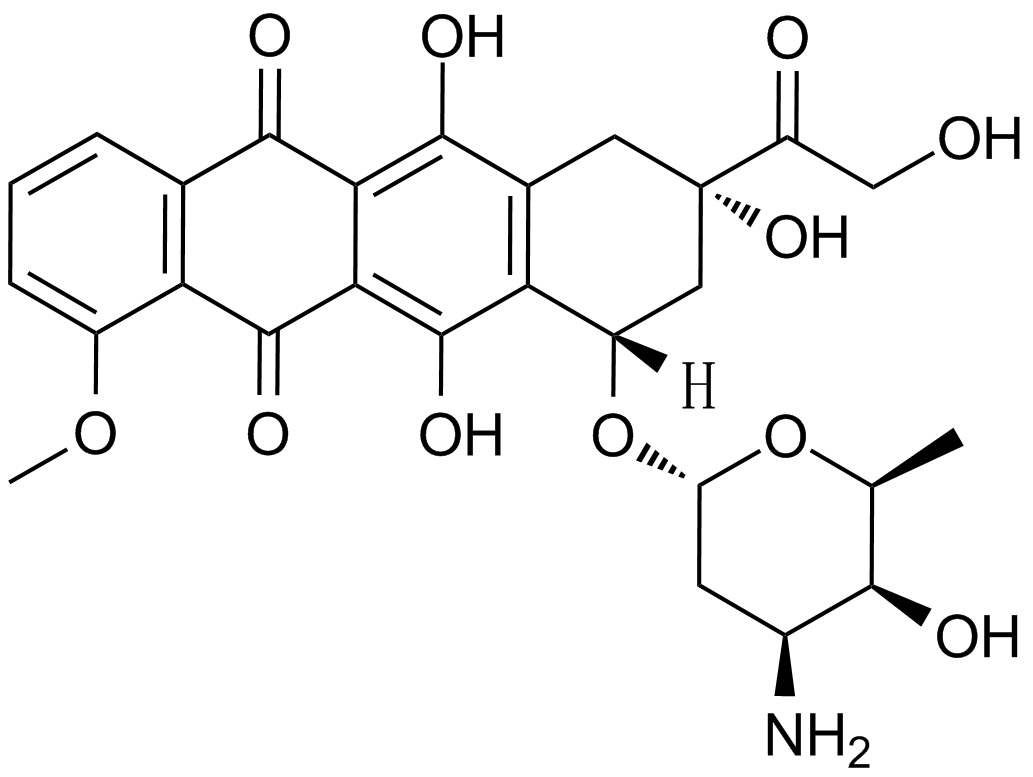
Related Biological Data

Related Biological Data
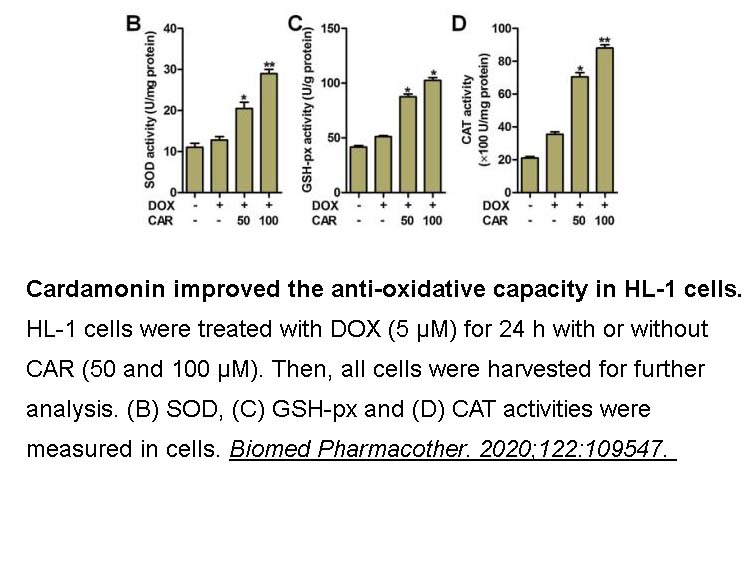
Related Biological Data

Related Biological Data

Related Biological Data
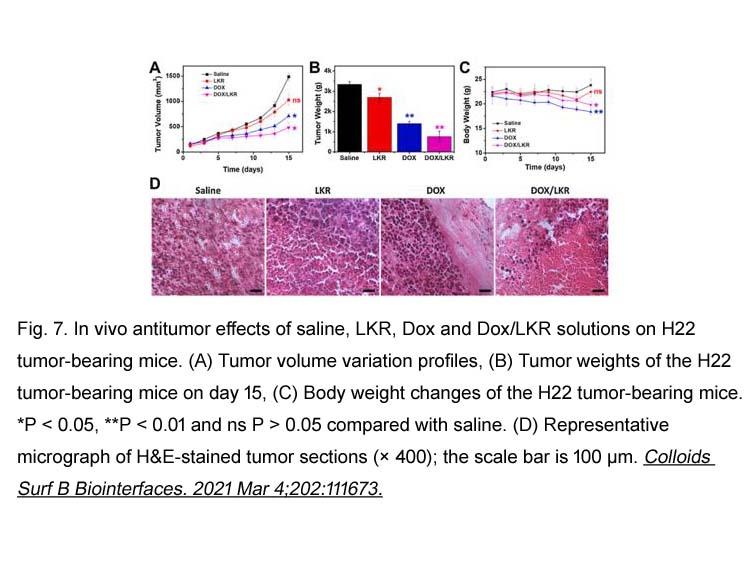
Related Biological Data
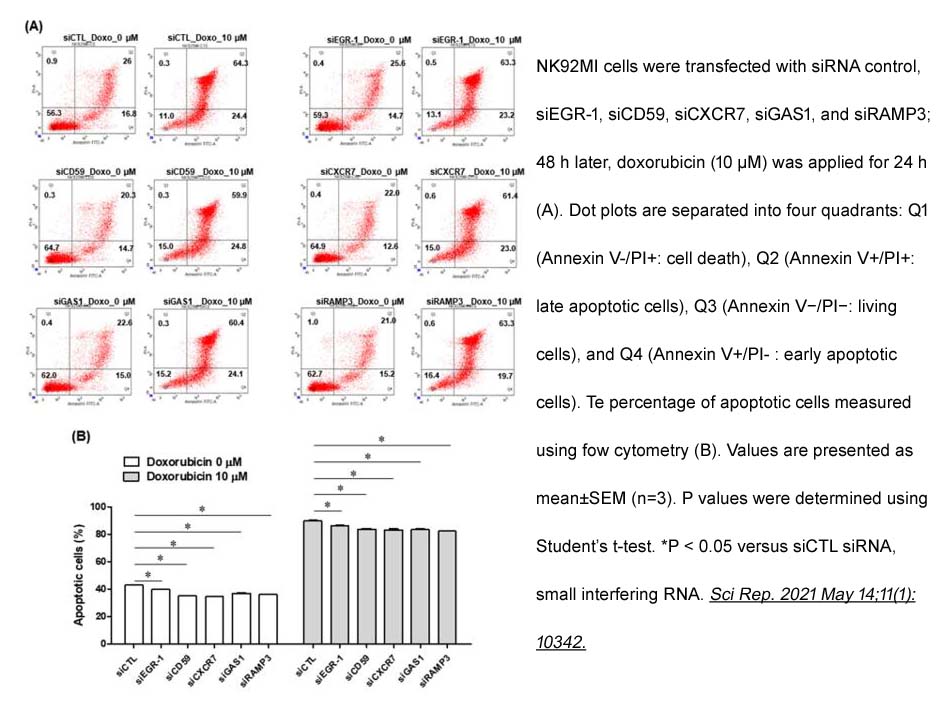
Related Biological Data
